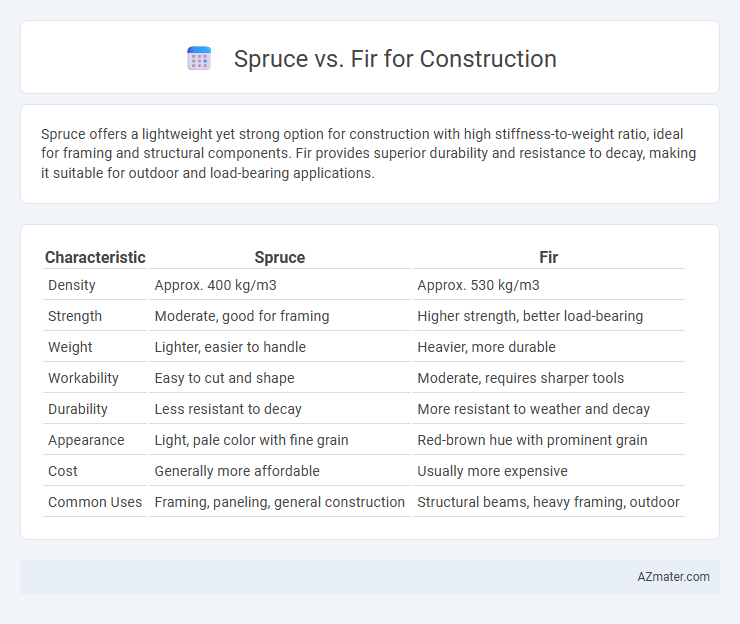Spruce offers a lightweight yet strong option for construction with high stiffness-to-weight ratio, ideal for framing and structural components. Fir provides superior durability and resistance to decay, making it suitable for outdoor and load-bearing applications.
Table of Comparison
| Characteristic | Spruce | Fir |
|---|---|---|
| Density | Approx. 400 kg/m3 | Approx. 530 kg/m3 |
| Strength | Moderate, good for framing | Higher strength, better load-bearing |
| Weight | Lighter, easier to handle | Heavier, more durable |
| Workability | Easy to cut and shape | Moderate, requires sharper tools |
| Durability | Less resistant to decay | More resistant to weather and decay |
| Appearance | Light, pale color with fine grain | Red-brown hue with prominent grain |
| Cost | Generally more affordable | Usually more expensive |
| Common Uses | Framing, paneling, general construction | Structural beams, heavy framing, outdoor |
Introduction to Spruce and Fir in Construction
Spruce and fir are commonly used softwoods in construction due to their favorable strength-to-weight ratios and workability. Spruce offers excellent stiffness and is often preferred for framing and structural components, while fir is known for its consistent grain and durability, making it ideal for beams and plywood. Both woods provide cost-effective solutions with good dimensional stability, crucial for building frameworks and load-bearing elements.
Botanical Differences Between Spruce and Fir
Spruce trees belong to the genus Picea and are characterized by their needle-like leaves attached individually to branches, with four-sided needles that roll easily between fingers. Firs, classified under the genus Abies, have flattened needles that are softer to the touch and attach directly to the twig with a base shaped like a small suction cup. These botanical distinctions influence their wood properties, with spruce typically offering lighter, straighter grain suitable for structural uses, while fir often provides a denser, more stout timber ideal for framing and heavy construction.
Physical Appearance and Grain Patterns
Spruce wood features a pale, creamy color with a subtle yellow or reddish hue, exhibiting a straight and fine grain pattern that enhances its uniform appearance for construction. Fir wood typically displays a reddish-brown to light tan color with a pronounced grain and distinct growth rings, creating a more textured and visually dynamic surface. Both species offer strong structural integrity, but spruce's smoother grain makes it ideal for interior finishes, while fir's bold patterns are favored for exterior applications and exposed beams.
Strength and Durability Comparison
Spruce and Fir are both popular choices in construction due to their favorable strength-to-weight ratios, but Fir generally offers higher density and better structural strength, making it more suitable for load-bearing applications. Douglas Fir, in particular, is renowned for its exceptional durability and resistance to wear, outperforming Spruce in long-term use and environmental exposure. While Spruce is lighter and easier to work with, Fir's enhanced mechanical properties provide superior resilience against stress and decay, making it a preferred material for framing and heavy construction.
Workability and Ease of Use
Spruce wood offers excellent workability due to its fine, even texture and lightweight nature, making it easy to saw, nail, and glue in construction projects. Fir, while slightly harder and heavier than spruce, provides superior strength and dimensional stability but may require more effort to cut and shape. Both woods are favored for framing and structural applications, but spruce's ease of use is preferred for detailed carpentry and quick assembly tasks.
Resistance to Decay and Insects
Spruce offers moderate resistance to decay and insect damage, making it suitable for indoor construction but less ideal for exposed outdoor applications. Fir, particularly Douglas Fir, exhibits superior natural durability and resistance to decay and insect infestation, making it a preferred choice for structural elements exposed to moisture. The inherent strength and resilience of Fir enhance the longevity of construction projects where environmental exposure is a concern.
Cost and Availability in the Market
Spruce is generally more affordable than fir, making it a cost-effective option for construction projects with tight budgets. Fir, while often pricier, is widely available in North American markets and valued for its strength and durability. Both woods have strong supply chains, but spruce's lower price point and abundant availability make it preferred for large-scale framing and structural applications.
Best Uses for Spruce in Construction
Spruce is highly valued in construction for its lightweight strength and excellent workability, making it ideal for framing, paneling, and structural components. Its consistent grain and moderate stiffness provide reliable support in residential and commercial buildings, especially in roof trusses and wall studs. Spruce's natural resistance to splitting and its ability to hold nails and screws securely enhance its suitability for both load-bearing and decorative applications.
Best Uses for Fir in Construction
Fir wood is highly valued in construction due to its exceptional strength, straight grain, and dimensional stability, making it ideal for framing, flooring, and heavy timber applications. Its resistance to warping and shrinking enhances structural integrity in load-bearing elements and exterior projects such as decking and siding. Fir's dense fiber composition also provides excellent nail-holding capability, ensuring long-lasting durability in both residential and commercial building projects.
Choosing the Right Wood: Spruce vs Fir
Spruce wood, known for its light weight and good strength-to-weight ratio, offers excellent workability and is commonly used in framing and structural elements. Fir wood, particularly Douglas Fir, provides superior durability, higher density, and greater resistance to wear, making it ideal for load-bearing applications and outdoor construction. Choosing between spruce and fir depends on project requirements: spruce excels in cost-effectiveness and ease of handling, while fir delivers enhanced structural integrity and longevity.

Infographic: Spruce vs Fir for Construction
 azmater.com
azmater.com